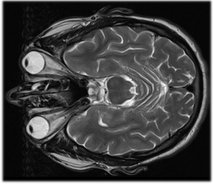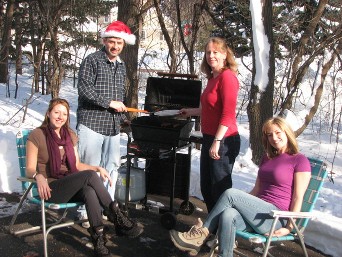Lucky Day
Holy friggatriskaidekaphobia!, today is Friday the 13th!
I don’t particularly remember ever having any bad luck on a Friday the 13th. But one year ago today on Thursday May 13th, I was told for the first time that I “likely” had Amyotrophic Lateral Sclerosis (ALS). Lou Gehrig’s “Luckiest Man on the Face of the Earth” speech notwithstanding, I didn’t exactly feel that the goddess Fortuna was smiling on me that day.
 It wasn’t until February 15th of this year that my symptoms and electromyographic evidence of more widespread involvement were enough for a definitive diagnosis of ALS. But it was a year ago that my first neurologist—after two EMG[1] and nerve conduction velocity studies, extensive MRIs (yes, that’s a picture of my head), numerous blood tests, and three clinical exams—told me and Joann what she feared, and referred me to a neuro-muscular specialist at the University of Minnesota’s ALS clinic. This was when, at the age of 49, I came face-to-face with the reality of my situation. There was a chance she was wrong, but we knew what she believed (she wasn’t shooting from the hip and was clearly reluctant give us the news), and there wasn’t any reason to question her expertise.
It wasn’t until February 15th of this year that my symptoms and electromyographic evidence of more widespread involvement were enough for a definitive diagnosis of ALS. But it was a year ago that my first neurologist—after two EMG[1] and nerve conduction velocity studies, extensive MRIs (yes, that’s a picture of my head), numerous blood tests, and three clinical exams—told me and Joann what she feared, and referred me to a neuro-muscular specialist at the University of Minnesota’s ALS clinic. This was when, at the age of 49, I came face-to-face with the reality of my situation. There was a chance she was wrong, but we knew what she believed (she wasn’t shooting from the hip and was clearly reluctant give us the news), and there wasn’t any reason to question her expertise.
So it’s been a year now of living with the idea of ALS.
And I do feel lucky.
First of all, I feel lucky to be alive. It was just over a year ago that an active and strong 44-year-old co-worker died in his sleep of a heart attack. Another co-worker, in her early 50s, died of a stroke just eight months ago. Both left behind spouses, children, family and friends to whom they never had a chance to say goodbye.
I’m lucky to be pretty darn healthy, all things considered. The usual statistics say that about half of ALS patients live as long as five years after diagnosis; the National Institute of Health (NIH) states that “most people with ALS die from respiratory failure, usually within 3 to 5 years from the onset of symptoms.” Almost all sources agree that about 10% live ten years or longer.
 The truth is that progression in ALS is quite variable, and mine so far has been slow. Some PALS (Persons with ALS) progress quite quickly and may be severely disabled—unable to walk, use their arms, breathe or eat without assistance—less than a year after first noticing symptoms of the disease. Almost two years after I first noticed symptoms, my impairments are limited: my left arm is quite weak and my left hand is worse (I use just one finger on it when I type; I cannot turn a key with it, etc). I tire easily and feel like I’m walking uphill all of the time. I’ve had to give up bike riding, basketball, volleyball and softball. But that’s about it. My balance is pretty good, I’m talking, eating, and breathing without difficulty. I’m lucky in this respect.
The truth is that progression in ALS is quite variable, and mine so far has been slow. Some PALS (Persons with ALS) progress quite quickly and may be severely disabled—unable to walk, use their arms, breathe or eat without assistance—less than a year after first noticing symptoms of the disease. Almost two years after I first noticed symptoms, my impairments are limited: my left arm is quite weak and my left hand is worse (I use just one finger on it when I type; I cannot turn a key with it, etc). I tire easily and feel like I’m walking uphill all of the time. I’ve had to give up bike riding, basketball, volleyball and softball. But that’s about it. My balance is pretty good, I’m talking, eating, and breathing without difficulty. I’m lucky in this respect.
Financially, ALS can be devastating. I am lucky that it shouldn’t be so in my case. I am a veteran of the U.S. Navy, and ALS is “presumed to be service-connected” for all veterans.[2] This means that I do not have to prove that my service caused my ALS to receive veteran’s benefits. In fact, I am already certified as service-connected and am receiving a small monthly disability check from the VA. I can continue to work and receive this benefit, and as my disabilities increase, my monthly benefit will increase. The VA will pay for all of my ALS-related medical care and equipment, and will provide generous grants to modify my home and vehicle when needed. Additionally, I will qualify for Social Security Insurance Disability five months after I quit working (or quit earning more than a $1,000 a month from working). Qualification is automatic with a diagnosis of ALS. Finally, last May during an open-enrollment period, Joann and I bought a long-term care (LTC) insurance policy. When (if!) my disability gets to the point where I need in-home care, the VA will pay for it. There will be a limit to the number of hours per week they will allot to me. With our LTC plan, though, we’ll be able to hire help to provide additional hours.

The rest of my family live out-of-state (most in California), and I’ll see them as often as I can as long as I’m able to travel. When I can’t, they’ll have more opportunities to visit beautiful Minnesota and I know they will. I am privileged to have good friends here in Minnesota and around the country. I won’t abandon them, and as long as I can walk, crawl or roll, they can expect to see me out birding, Scrabbling, at Brit’s Pub for trivia, participating in the Minnesota Master Naturalist program, on the softball diamond (this year I’m managing the team I played with for 15 seasons), at weekly post-volleyball carbo re-loads, at Orchestra Hall, the Cedar, the Guthrie, the GRSF and at most of the other places I’ve been know to haunt. We are in the process of buying a larger house that will give us more room to entertain family and friends at home.
Yes, I’m feeling lucky today.
| DATE | TITLE |
| 02/28/2019 | Unhappy Anniversary |
| 05/12/2017 | The Eyes Have It |
| 08/04/2016 | YFALS National Corntoss Challenge |
| 07/18/2016 | Scopolamine Blues |
| 03/06/2016 | Dragon Me Down |
or see the Complete ALS Bites
—
Notes:
- An Electromyograph (EMG) detects the electrical potential generated by muscle cells and is used to diagnose neuropathies, neuromuscular junction diseases and myopathies. [^]
- From www.vawatchdog.org: The VA’s decision [in August of 2008] to change eligibility requirements relied heavily upon a 2004 study of men in the service; it found that, from 1910 to 1982, service members had a nearly 60 percent greater risk of the disease than men who had never served. The increase “appeared to be largely independent of the branch of the service and the time period served,” Harvard University researchers concluded. Earlier, a couple of Gulf War veteran studies found that they were also at increased risk. [^]
